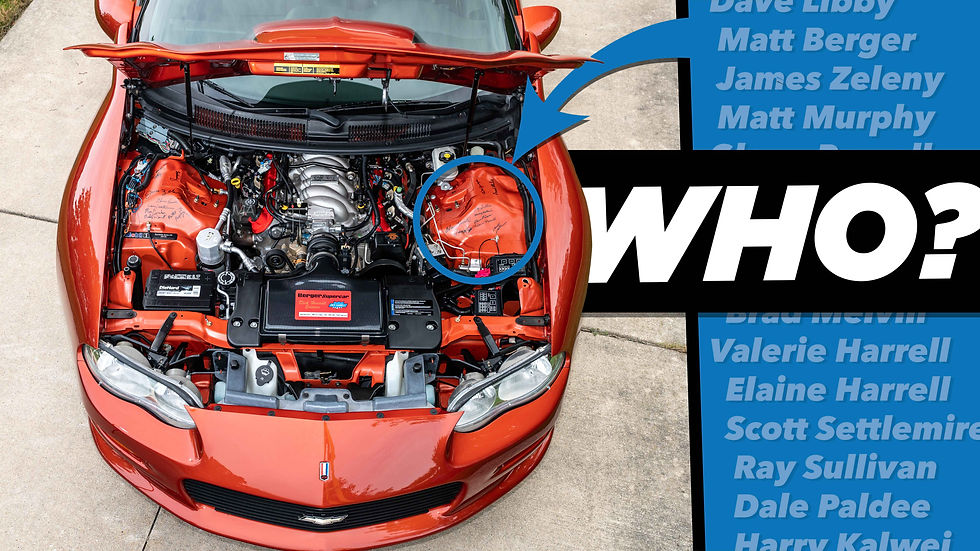What is the 2002 GMMG ZL1 Supercar Camaro? Everything You Need to Know!
- Matt Avery

- Apr 28
- 7 min read
Updated: May 1

The 2002 ZL1 Supercar Camaro stands as one of the rarest, most powerful, and most collectible fourth-generation Camaros ever built. Born from a passion for performance and heritage, this limited-edition modern muscle car was developed by GMMG, Inc., a specialty performance shop based in Marietta, Georgia, and available for purchase through select Chevrolet showrooms.
After producing several successful limited-edition Camaro packages, GMMG set out to create their modern tribute to the iconic 1969 ZL1 Camaro — considered by most to be the ultimate Camaro icon.
True to the original’s legacy, only 69 examples of the 2002 ZL1 Supercar were produced, and sold in collaboration with Chevrolet dealerships across the country. These Camaros were packed with retro styling cues, high-performance components, and engine upgrades capable of producing up to 600 horsepower.
Here's everything you need to know.
Revival of a Legend: B4C to ZL1
In 1969, Chevrolet produced just 69 ZL1 Camaros through their backdoor COPO program, each equipped with an all-aluminum 427ci engine with the intent of dominating drag racing. More than three decades later, GMMG brought that same spirit back to life.
Using B4C special service Camaros as the foundation, they worked with select dealers—including Berger Chevrolet, Hendrick Chevrolet, and Tom Henry Chevrolet—to build a new generation of ZL1 Supercars.
The package enhancements elevated the ZL1 Supercar's performance well beyond that of the standard Z28 or even the SS models, offering enthusiasts a showroom-sourced, high-performance Camaro that paid proper homage to the model's muscle car heritage.

2002 ZL1 Supercar Camaro Phase 1 Package
The Phase 1 package for the 2002 ZL1 Supercar Camaro delivered serious performance enhancements and aesthetic upgrades.
Under the hood, the Camaros featured the powerful LS6 GM Performance Parts Corvette engine, complemented by CNC ported and cast gray-painted exhaust manifolds and a cat-back chambered exhaust system with stainless tips.

Performance was further boosted with underdrive pulleys and belts, a high-flow MAF housing, a carbon-fiber-type air box lid with a '99 GM air filter and tube, and a 180-degree thermostat. The Mobil 1 oil fill cap and Mobil 1 underhood decal reinforced the commitment to high-performance lubrication. Additionally, underhood coolant and emission stickers provided essential information and contributed to the vehicle's authenticity.
Handling and braking saw major improvements thanks to Penske Racing shocks, Eibach front and rear lowering springs, special front and rear sway bars, and 1LE lower control arms with a Panhard bar. The Z06 brake calipers, Corvette brakes, and slotted Z06 rotors delivered race-worthy stopping power. Z06 wheels measuring 18x9.5 inches were wrapped in Goodyear Eagle F1 Supercar tires sized 275/40ZR18, ensuring optimal grip and stance.

Cosmetic upgrades included a GM 'SS' hood and SS spoiler, a satin black 35th Anniversary center hood decal, a charcoal metallic grille with a '69-style Bowtie emblem, and a painted rear panel with high-polished stainless CAMARO lettering. Inside, a Cloisonné dash plaque, silver-face gauge insert, numbered door jamb plate, and special key fobs added exclusivity.
A Hurst shift ball (white or black) with a short-throw stick shift enhanced the driving experience. The inclusion of a GM power antenna and a rearview mirror equipped with compass, temperature, and auto-dimming features added modern conveniences to this classic-inspired muscle car.

Completing the package were a bespoke car cover, embroidered floor mats, and ZL1 car numbers on the front window (at the base on the driver's side) and rearview mirror, making each example readily identifiable.
GMMG recommended a break-in period of 500 miles of easy driving with alternating RPMs to ensure optimal engine performance and longevity. The base Camaro Special Service Package was priced at $25,705, with the ZL1 package adding around another $34,845, plus a $150 emission re-certification fee. Phase 1 cars ended up being priced around $65,000. Credits were issued for the take-off parts.
Optional Phase 2 & 3 Packages
Building upon the base Phase 1 package, GMMG offered two performance upgrade options: Phase 2 and Phase 3. Due to the historic nature of the run, many customers opted for these enhancements to maximize performance and collectibility.
Phase 2 Upgrade
For an additional $6,995, the Phase 2 package introduced larger exhaust headers and cutouts, boosting the LS6 V8's output to 475 horsepower and 440 lb-ft of torque. This enhancement provided a more aggressive exhaust note and improved performance.
Phase 3 Upgrade
The pinnacle of GMMG's offerings, the Phase 3 package, was priced at $23,995 and built upon the Phase 2 enhancements. It featured a 427ci C5R race engine, delivering 600 horsepower and 575 lb-ft of torque. These top-tier models were distinguished by a retro-inspired hockey stick stripe, available in white, black silver, and red, running along the profile from the front fender with '427' callouts. Only 31 of these Phase 3 Camaros were produced, making them highly sought after by collectors.
Additional Options
Customers could further personalize their ZL1 Supercar with options such as a Hurst line lock ($395) and a 6-point roll cage ($1,295). Custom paint finishes were also popular, with this option costing around $7,500.
Key Features of the ZL1 Supercar
LS6 engine with custom internal upgrades
Cat-back chambered exhaust with stainless tips
Penske racing shocks, Eibach springs, and custom sway bars
Z06-spec brakes with slotted rotors and Corvette pads
Custom appearance package with “SS” hood, spoiler, and graphics
Special interior trim, including optional houndstooth inserts
Numbered dash plaques, key fobs, and door jamb plates for authenticity

Distribution by Dealership
While GMMG, Inc. was responsible for the performance modifications of the run, the completed vehicles were distributed through a network of 12 select Chevrolet dealerships across the United States.
Berger Chevrolet in Grand Rapids, Michigan, played a pivotal role in this distribution, selling the majority (28 cars). Their collaboration with GMMG was a natural extension of their previous joint ventures, including the Berger SS Camaro program. Berger's deep-rooted history in high-performance Chevrolet models made them an ideal partner for the ZL1 Supercar project.
Delivery day at Berger in 2003 was quite a special event, with the completed vehicles all showcased togother in the historic dealership.
Each ZL1 Supercar was equipped with an underhood plaque mounted on the driver's side strut tower. This plaque detailed the selling dealership, the original owner's name, and the car's specific number within the production sequence, adding a personalized touch and enhancing the vehicle's collectibility.

Dealership | Cars Ordered |
Berger Chevrolet | 28 |
Henderson Chevrolet | 7 |
Hendrick Chevrolet | 7 |
Tom Henry Chevrolet | 4 |
Superior Chevrolet | 4 |
Purifoy Chevrolet | 4 |
Jack Cauley Chevrolet | 4 |
West Chevrolet | 3 |
Green Chevrolet | 2 |
Johnny Londoff Chevy | 2 |
Lujack Chevrolet | 2 |
Dave Kirk Automotive | 1 |
Why is the ZL1 Supercar so rare?
Only 69 cars were built, each numbered and documented. They were offered through just 12 Chevrolet dealers, with Berger Chevrolet accounting for more than 40% of the total production. Unlike typical production Camaros, each ZL1 Supercar was built to order with custom specs.
Some cars received custom colors, retro-themed graphics, or upgrades to honor historical drag cars. For example, Car #69 was a tribute to Bill “Grumpy” Jenkins and featured special livery.
Current Values & Collectibility
With low production numbers and extreme desirability, the 2002 ZL1 Supercar Camaro has become one of the most sought-after modern 4th-generation Camaros. Values have been steadily climbing as collectors recognize their historical significance, exceptional craftsmanship, and raw performance.
Auction results show that clean examples of Phase 3 cars regularly reach six figures, especially when they retain original documentation and showcase custom paintwork. Today, many ZL1 Supercars reside in private collections and top automotive museums, often driven sparingly to preserve their condition.
Part of their lasting appeal comes from the combination of high levels of fit and finish, attention to detail, and radical performance upgrades that set them apart from even the best factory offerings of the time.

The Legacy Left Behind
While the "ZL1" trim is common among enthusiasts today, thanks to Chevrolet’s adoption of the performance trim on the 5th- and 6th-generation Camaros, the 4th-gen ZL1 Supercar was the first true modern revival of the legendary and soul-stirring 1969 COPO ZL1.
It wasn’t just about stickers and badging. It was a serious effort to build a top-tier, showroom-ready Camaro that paid real tribute to its predecessor. If Chevrolet wasn’t going to do it, GMMG and clued-in dealers stepped in and made it happen—and they absolutely delivered.
The 2002 ZL1 Supercar Camaro set a new standard for what a modern muscle car tribute could be, paving the way for future high-performance Camaros and cementing its own place as a legend in its own right.
Frequently Asked Questions about GMMG's ZL1 Supercar
Q: How many 2002 ZL1 Supercars were built?
A: Only 69 ZL1 Supercar Camaros were built as part of the numbered run by GMMG in partnership with Chevrolet dealers. An additional 3 prototypes were also assembled, marking 72 total vehicles related to the run.
Q: What engine does the 2002 ZL1 Camaro have?
A: The Phase 1 cars were powered by an LS6 V8 engine, similar to what was used in the Corvette Z06 at the time. Phase 3 cars were equipped with a C5R race engine.
Q: Are the ZL1 Supecars COPOs?
A: No, the run of ZL1 Supercars are not COPOs as they were not processed through General Motors' Central Office Production Order system like the predecessor - the 1969 Camaro ZL1.
Q: What’s the most valuable ZL1 from the 2002 run?
A: The high-horsepower Phase 3 builds with documentation tend to be the most valuable, along with examples that received custom paint.
Q: Is the 2002 ZL1 Camaro street-legal?
A: Yes, the ZL1 Supercars were built to be fully street-legal while offering extreme levels of performance.
Q: Who is GMMG?
A: GMMG, Inc. was a performance shop based in Marietta, Georgia. They specialized in limited edition runs of Camaros and Firebirds with factory-level fit and finish. They opened in 1999 and closed around 2011.
For even more on this rare 4th-gen legend, visit the GMMG ZL1 Supercar Camaro overview.



Comments